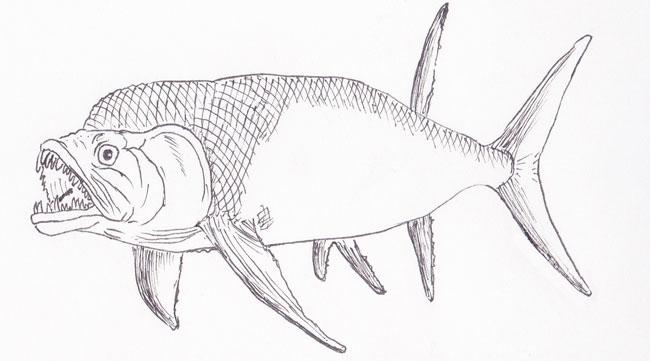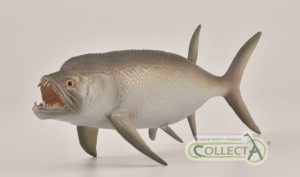Major Fossil Excavation Site Continues in Manitoba
A very significant fossil excavation is continuing in Manitoba province (Canada), with researchers and field workers from the Canadian Fossil Discovery Centre working on strata deposited during the Late Cretaceous.
Fossil Excavation
In 2010, the Centre served notice that a massive Xiphactinus fish and mosasaur skeleton were being unearthed at one of its palaeontological dig sites. The excavation of these skeletons continues with great success and has lead to a number of other significant fossil discoveries in 2011, providing an intriguing insight into marine environments in the Late Mesozoic.
A Drawing of the Fearsome Xiphactinus

The Xiphactinus drawing that was commissioned by Everything Dinosaur as the company prepares for the arrival of the CollectA Xiphactinus 1:40 scale replica. Picture credit: Everything Dinosaur.
Picture credit: Everything Dinosaur
Museum curator Anita Janzic explained:
“This dig site continues to be extremely productive, with the appearance of even more fossils than anticipated. Our excavation of the Xiphactinus and mosasaur skeletons from 2010 has allowed us to find another mosasaur, a squid and some Ichthyornis (bird) fossils. We are finding layer upon layer of exciting fossil discoveries. It is amazing how one small dig site is producing such an abundance of diverse fossils.”
The scientific information being generated from this dig site could have far reaching global impact for the palaeontological community. The dig site is providing a high quality and isolated look into the detailed passage of time during the Late Cretaceous period.
Assistant curator of the Centre, Joseph Hatcher stated:
“This dig site is showcasing the most exciting five inches of rock that I’ve ever witnessed. This small layer of rocks is suggesting a rapid change in the palaeoecology and environment of prehistoric Manitoba. There is great science emerging from this dig site that has our team very excited!”
The rock units at this dig site are also of increasing interest to the Manitoba Geological Survey, with the appearance of a previously unseen rock layer for southern Manitoba.
A Model of the Fearsome Prehistoric Fish Xiphactinus
Xiphactinus Fish
The ironic element of this dig site is that the most provoking skeleton, the Xiphactinus fish, might be the last set of fossils to be removed from the site. This excavation continues to unearth other new & exciting fossil discoveries, in the rock layers above the fish skeleton, which must be properly processed first. Xiphactinus grew to lengths of up to 6 metres and has been nicknamed the “Bulldog fish” due to its ugly appearance.
The new discoveries include another mosasaur, two unidentified fossils, squid fossils and bird fossils. The two unidentified fossils are of great interest to the palaeontologists on staff at the Centre and we look forward to hearing more about these discoveries in the future.
To view replicas of marine reptiles including mosasaurs and a model of the fearsome prehistoric fish Xiphactinus, check the CollectA Deluxe models section of our our website: Scale Models of Prehistoric Animals (CollectA Deluxe).







Leave A Comment